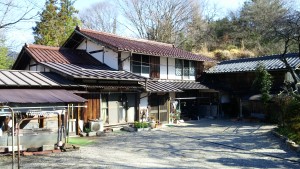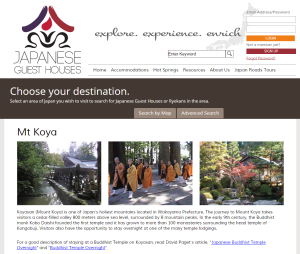Tip 1: Be able to read Japanese
Okay, that’s not good advice. Let’s try again.
Tip 2: Have family or friends that can read Japanese
Okay, say you don’t have that either. What if you don’t know Japanese and would still like to experience an authentic Japanese ryokan experience?
The different types of Japanese style lodging
First of all, there are a couple of types of Japanese style lodgings. Ryokan are the full blown traditional Japanese style inn experience with Japanese style rooms. They will typically include dinner and breakfast. Often they will have either a private or shared bath (onsen.) Ryokan will usually be in the price range of 6,000 to 30,000 yen per person.
Minshuku are the budget version of ryokan, which are more like a Japanese “bed and breakfast.” They are typically family run, and often include 1 or 2 meals in the price. They will most likely have less total rooms than a ryokan or hotel will. These will usually be in the price range of 4,000 to 10,000 yen per person.
There are also Japanese hotels that have both Japanese style rooms and Western style rooms. Meals may be served in the room or in the hotel restaurant. These also will often have a private or shared baths (onsen.) I consider staying in a Japanese style room with in room meals at one of these hotels as similar enough to ryokan that I will count it as a ryokan in this guide.
For something more unique, there are also Buddhist temple lodgings (shukubo.) These are somewhat like ryokan in that there will be Japanese style rooms and meals included (vegetarian only!) However, they also include glimpses into the daily lives of Japanese monks. The best place to experience this is at Mount Koya, and you can book these through the official tourist association website or through Japanese Guest Houses.
I consider all of these very unique and wonderful experiences. It’s up to your personal taste how traditional and what level of comfort that you want to have. The methods covered in this guide should work for all these types of lodgings.
Finding Japanese style lodgings
First, you need to figure out what the available ryokan in an area are. I use a combination of tools for this.
japaneseguesthouses.com is a great service which is totally free. Per the name, they have a listing of Japanese Guest Houses in each region of Japan in English, along with reviews and detailed information on the lodging. Furthermore, they can help you make inquiries and reservations to various lodgings for availability, and you should be able to get the same price as if you booked directly. There are some small downsides to the site. Not all ryokan/minshuku/Japanese style hotels in the area are listed on Japanese Guest Houses. Also, they are not hooked up electronically to any reservation system so you are unable to instantly view availability and prices for any particular stay. The site is run by a small company, and they often will take around a day to respond.
Next are Japan specific OTAs. Japanican, Jalan, and Rakuten Travel are good examples, and all 3 of these have English version sites. On these sites, like any normal OTA, you are able to check availability and pricing instantly. I’ve found that Jalan sometimes has lodgings in its Japanese site that don’t appear on the English site, or may not offer as many options. This might be a good time to find your nearest Japanese speaking friend.
I also find that TripAdvisor does a good job of aggregating the above OTAs to do price comparisons. To figure out if a lodging is a ryokan or minshuku versus a normal hotel, just peek in the reviews or description to figure out what type of lodging it is. I tend to find that filtering for “Japanese Guest Houses” removes many places from the listing, as not all places are categorized correctly on TripAdvisor. Sometimes an OTA will be cheaper than booking directly, so it pays to do some price comparison. Also, if you go down the list of lodgings on TripAdvisor, you will often find lodgings that are on TripAdvisor but have no information on pricing or availability. This usually means that the lodging is only available to be booked using the hotel website, which usually is only in Japanese. This is when grabbing the name of the place in Japanese, pasting it into Google, and finding your Japanese friend helps.

If you get this, click get name/address in local language and Google it. Might be time to brush up on those foreign language skills
I also often find that often popular tourist areas will have an official or unofficial website for tourists with a listing of the various lodgings available, and can tell you whether a lodging is a ryokan, minshuku, or a normal hotel. Googling “ryokan [insert name of area/city]” tends to work for finding these. For example, I’m thinking of visiting the Shirahama area on my upcoming trip to Japan, and I easily found this page with a list of places to stay. Again, if you go this route, Google the name of the lodging to see if it is available with an English OTA, or only through the lodging website.
I do not encourage booking Japanese style lodgings with meals through a foreign OTAs, as usually they will offer less options in terms of meals or have higher prices, or have worse cancellation policies. Also, foreign OTAs don’t seem to understand the concept of the rate being per-person as well as Japanese OTAs do. If you do find one through a foreign OTA that matches the price, meals, and cancellation policy, go for it.
Personally, since I can read Japanese, I tend to book directly on the place’s website or through emailing the lodging directly, as typically I get the best rates and cancellation policy this way. The only reason I wouldn’t do this is if I found a better price on an OTA.
Booking and comparing prices
Now how do we book and compare prices? Ryokan and minshuku are almost always charged per person, especially if there are meals involved. I would check the Japanese OTAs, then if you can access the lodging website in English or can find a Japanese friend, do a comparison to the price and options there. Get a quote from Japanese Guest Houses too if the prices you are getting are out of the range of the price ranges on Japanese Guest Houses.
If the lodging doesn’t even have an online reservation system, it’s time to turn to email! Or in the worst case when they don’t have email and only a phone number… Skype. This might be a good time to find your Japanese friend.
Booking details and policies
Often during the booking process, sites will ask you for your phone number in Japan and your postal code in Japan and city. These are not really validated, so you can put your normal mobile phone number, and just find some random address in Japan and put that postal code. If there is freeform input, I just put my home address in English. Also, if I’m planning to get a SIM card in Japan, I’ll write a note that I am planning to get a Japanese phone number when I arrive, and that I’ll update them when I get that number.
How do you pay for a ryokan? Most commonly, ryokan and minshuku are paid for upon checkout, and are often cash only. More and more lodgings nowadays seem to be accepting credit cards. Cancellation policies tend to be fee free if cancelled 2-3 days before, and some percentage fee if the cancellation period is shorter than that. Often times, you don’t even need to put down a credit card to hold the reservation, as it operates on a trust policy. Please be respectful of this, to keep places friendly to foreigners in the future.
Now go enjoy your trip to Japan! Maybe take advantage of some of the recent flight deals to Japan?



